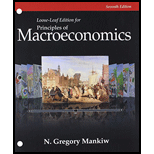
Subpart (a):
Real interest rate before and after the tax.
Subpart (a):
Explanation of Solution
Before the tax real interest rate is calculated using the formula:
Substitute the respective values in equation (1) to calculate the real interest rate.
Thus, before the tax real interest rate is 5%.
The reduction in the nominal interest rate (Reduction NI) due to 40% tax is given as follows:
Thus, reduction in nominal interest rate due to tax is 4%.
After the tax nominal interest rate is calculated using the formula:
Substitute the respective values in equation (2) to calculate the nominal interest rate.
Thus, after the tax nominal interest rate is 6%.
After the tax real interest rate is calculated using the formula:
Substitute the respective values in equation (3) to calculate the real interest rate.
Thus, after the tax real interest rate is 1%.
Concept introduction:
Inflation: It is an increase in the general price level of goods and services in an economy over a period.
Nominal interest rate: It is the interest rate that measures the change in dollar amounts.
Real interest rate: It is the interest rate adjusted with inflation, which is measured by the difference between nominal interest rate and inflation rate.
Subpart (b):
Real interest rate before and after the tax.
Subpart (b):
Explanation of Solution
Substitute the respective values in equation (1) to calculate real interest rate before tax.
Thus, before the tax real interest rate is 4%.
The reduction in the nominal interest rate (Reduction NI) due to 40% tax is given as follows:
Thus, reduction in nominal interest rate due to tax is 2.4%.
Substitute the respective values in equation (2) to calculate the nominal interest rate after tax.
Thus, after the tax nominal interest rate is 3.6%.
Substitute the respective values in equation (3) to calculate the real interest rate after tax.
Thus, after the tax real interest rate is 1.6%.
Concept introduction:
Inflation: It is an increase in the general price level of goods and services in an economy over a period.
Nominal interest rate: It is the interest rate that measures the change in dollar amounts.
Real interest rate: It is the interest rate adjusted with inflation, which is measured by the difference between nominal interest rate and inflation rate.
Subpart (c):
Real interest rate before and after the tax.
Subpart (c):
Explanation of Solution
Substitute the respective values in equation (1) to calculate the real interest rate before tax.
Thus, before the tax real interest rate is 3%.
The reduction in the nominal interest rate (Reduction NI) due to 40% tax is given as follows:
Thus, reduction in nominal interest rate due to tax is 1.6%.
Substitute the respective values in equation (2) to calculate the nominal interest rate after tax.
Thus, after the tax nominal interest rate is 2.4%.
Substitute the respective values in equation (3) to calculate the real interest rate after tax.
Thus, after the tax real interest rate is 1.4%.
From the results, it can be inferred that the after-tax real interest rate is much lower than the before-tax real interest rate.
Concept introduction:
Inflation: It is an increase in the general price level of goods and services in an economy over a period.
Nominal interest rate: It is the interest rate that measures the change in dollar amounts.
Real interest rate: It is the interest rate adjusted with inflation, which is measured by the difference between nominal interest rate and inflation rate.
Want to see more full solutions like this?
Chapter 17 Solutions
Bundle: Principles of Macroeconomics, Loose-Leaf Version, 7th + LMS Integrated Aplia, 1 term Printed Access Card
- how commond economies relate to principle Of Economics ?arrow_forwardCritically analyse the five (5) characteristics of Ubuntu and provide examples of how they apply to the National Health Insurance (NHI) in South Africa.arrow_forwardCritically analyse the five (5) characteristics of Ubuntu and provide examples of how they apply to the National Health Insurance (NHI) in South Africa.arrow_forward
- Outline the nine (9) consumer rights as specified in the Consumer Rights Act in South Africa.arrow_forwardIn what ways could you show the attractiveness of Philippines in the form of videos/campaigns to foreign investors? Cite 10 examples.arrow_forwardExplain the following terms and provide an example for each term: • Corruption • Fraud • Briberyarrow_forward
- In what ways could you show the attractiveness of a country in the form of videos/campaigns?arrow_forwardWith the VBS scenario in mind, debate with your own words the view that stakeholders are the primary reason why business ethics must be implemented.arrow_forwardThe unethical decisions taken by the VBS management affected the lives of many of their clients who trusted their business and services You are appointed as an ethics officer at Tyme Bank. Advise the management regarding the role of legislation in South Africa in providing the legal framework for business operations.arrow_forward
 Essentials of Economics (MindTap Course List)EconomicsISBN:9781337091992Author:N. Gregory MankiwPublisher:Cengage Learning
Essentials of Economics (MindTap Course List)EconomicsISBN:9781337091992Author:N. Gregory MankiwPublisher:Cengage Learning Brief Principles of Macroeconomics (MindTap Cours...EconomicsISBN:9781337091985Author:N. Gregory MankiwPublisher:Cengage Learning
Brief Principles of Macroeconomics (MindTap Cours...EconomicsISBN:9781337091985Author:N. Gregory MankiwPublisher:Cengage Learning
 Exploring EconomicsEconomicsISBN:9781544336329Author:Robert L. SextonPublisher:SAGE Publications, Inc
Exploring EconomicsEconomicsISBN:9781544336329Author:Robert L. SextonPublisher:SAGE Publications, Inc Principles of Economics (MindTap Course List)EconomicsISBN:9781305585126Author:N. Gregory MankiwPublisher:Cengage Learning
Principles of Economics (MindTap Course List)EconomicsISBN:9781305585126Author:N. Gregory MankiwPublisher:Cengage Learning Principles of Macroeconomics (MindTap Course List)EconomicsISBN:9781285165912Author:N. Gregory MankiwPublisher:Cengage Learning
Principles of Macroeconomics (MindTap Course List)EconomicsISBN:9781285165912Author:N. Gregory MankiwPublisher:Cengage Learning





